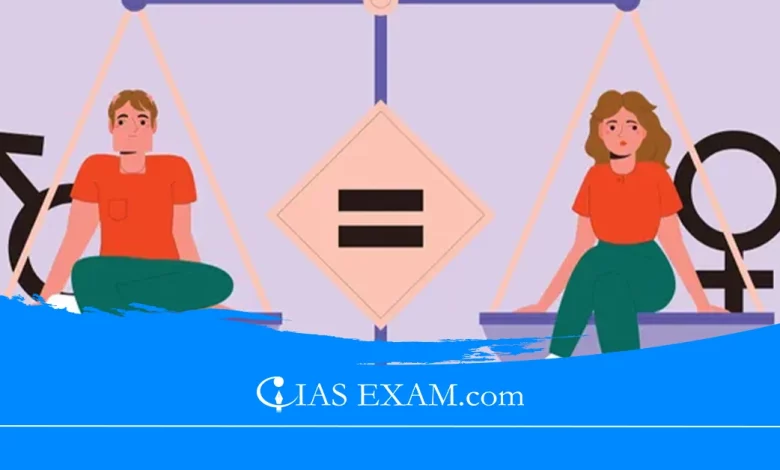Daily Current Affairs for UPSC
Gender diversity in India’s justice delivery system
Syllabus- Social Issues [GS Paper-1]

Context
On International Women’s Day, it is important to look into the state of gender diversity in India’s justice delivery system, as highlighted in the recent India Justice Report (IJR).
Disparities Highlighted by India Justice Report (IJR)
- Subsystem Disparities
-
-
- The IJR highlights that the gender gap extends its reach into every subsystem of the justice delivery system, together with the police, judiciary, prisons, legal aid, and human rights commissions.
- This comprehensive document highlighted the systemic nature of the issue, suggesting that the problem is not isolated however pervasive across all aspects of the justice system.
-
- Quotas and Limited Progress
-
-
- While quotas had been instrumental in facilitating the inclusion of women, their effect seems to be concentrated in lower echelons of the justice delivery system.
- The document’s facts shows that notwithstanding these affirmative action measures, women aren’t proportionately represented in higher-rating positions.
-
- Numerical Underrepresentation
-
-
- A brief estimation in the IJR exposes the stark reality that there are about only three lakh women in the justice delivery system.
- The numbers now not only replicate an inadequate representation but additionally trace at deeper structural troubles inhibiting the whole participation of women in the justice system.
-
- Judiciary’s Gender Disparity
-
-
- In the judiciary, the statistics exhibits a concerning trend wherein, regardless of the presence of women in the lower ranks, their numbers appreciably decrease as one ascends the hierarchy.
- For instance, at the same time as 35% of subordinate judges are women, this share plummets to a mere 13% in the high courts.
- The obvious loss of women in the Supreme Court, with three women judges, increases questions about the accessibility and inclusivity of the highest echelons of the justice system.
-
- Leadership Void
-
- The maximum glaring is the absence of a woman Chief Justice of India, a role that has remained elusive to women despite many years of existence.
- Even in high courts, where the glass ceiling should have been shattered over the years, 16 women have held the position of leader justice for over seven decades.
- This leadership void underscores the entrenched limitations stopping women from reaching the top of the judicial hierarchy.
NHRC’s Gender Imbalance and Limited Women Representation
- The NHRC, predicted as an exemplar of equity and justice, has failed in embodying those concepts concerning gender representation.
- The IJR reveals that, at some stage in its life, the NHRC has in no way had a woman commissioner.
- This absence of women at the only ranges of selection-making in a commission tasked with safeguarding human rights is a stark instance of institutional apathy towards gender diversity.
- The IJR’s findings expand beyond the NHRC, encompassing state commissions as well.
- Across the country, these establishments exhibit a striking lack of subject for gender diversity. As of 2022, most effective six commissions had women serving as participants or secretaries.
- The absence of women chairpersons, with only Kerala, Meghalaya, and Punjab having a lone woman member every, emphasises the entrenched nature of gender imbalance in those pivotal bodies.
Possible Reasons Behind the Disparity
- Lack of Initiative: Institutional Apathy
-
-
- The dearth of women in key roles in these commissions reflects no longer only a numerical deficiency but also a loss of initiative to actively address and rectify this imbalance.
- The IJR findings recommend a notable apathy in those institutions, wherein the imperative to foster gender variety is either left out or deemed a secondary concern.
-
- Complacency
-
-
- The state commissions, mirroring the NHRC’s deficiencies, fail to function as beacons of gender inclusivity.
- The IJR’s information presents a disheartening photograph, with only a handful of commissions displaying a willingness to rent women to decision-making positions.
- The absence of proactive measures to rectify this imbalance perpetuates an institutional way of life detached to the blessings of diverse perspectives and reports.
-
- Deflection of Responsibility
-
- Instead of addressing the root causes of gender disparity, decision-makers in those establishments regularly move to deflecting responsibility.
- The excuse of “issues” in “accommodating” greater women is a not unusual deflection tactic, diverting attention from the pressing need to assign present institutional structures and cultures that inhibit the entry and retention of women.
Potential Benefits of Creating Diversity in the Justice Delivery System
- Global Research Findings
-
-
- Across the world, studies always underscore the nice impact of various and inclusive offices.
- The IJR aligns with this global angle, emphasising that the inclusion of women, in conjunction with other diversities, has the capability to reshape institutional lifestyle in the justice system.
- It challenges the status quo by introducing fresh views, reviews, and approaches that make a contribution to a more comprehensive know-how of complicated issues.
-
- Internal Dynamic Transformation
-
-
- The inclusion of women in traditionally male-dominated establishments alters inner dynamics by hard entrenched norms and fostering a subculture of openness.
- This transformation extends beyond mere numerical illustration; it involves the mixing of numerous viewpoints, communication styles, and hassle-fixing tactics.
- Women, as imperative members, can catalyse a shift towards greater collaborative, empathetic, and innovative decision-making strategies.
-
- Enhanced Public Perception
-
- Inclusive establishments no longer only advantage internally however additionally enhance public agreement and perception.
- The justice delivery system, while reflective of the various populations it serves, will become greater responsive, credible, and representative of societal values.
- This alignment among the group and the general public it serves strengthens the legitimacy and effectiveness of the justice device, fostering a sense of trust and inclusivity.
Way Forward
- Institutional Preparedness
-
-
- The name for institutional change starts with a demand for preparedness. Justice directors are entreated to proactively deal with the systemic challenges hindering the inclusion of women.
- This entails a complete assessment of current structures, regulations, and practices to discover and dismantle boundaries that avert the total and equitable participation of women at all levels of the justice system.
-
- Leadership by Example
-
-
- The absence of a woman Chief Justice of India and the scarcity of women in leadership roles in the judiciary underscore the need for a paradigm shift.
- Institutions have to actively promote and support the upward thrust of women to leadership positions, challenging preconceived notions and dismantling the glass ceiling that has traditionally confined their upward mobility.
-
- Re-exam of Recruitment and Retention Practices
-
- There is a want for a crucial re-exam of recruitment and retention practices in the justice transport system.
- This includes a radical assessment of hiring practices, promoting standards, and measures to ensure the equitable treatment of women and men throughout their careers.
Source: The Indian express
UPSC Mains Practice Questions
Q.Discuss the desirability of greater representation to women in the higher judiciary to ensure diversity, equity and inclusiveness. (2021)





.png)



